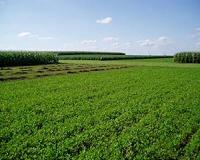 |
Breidabolstadur, Iceland (AFP) May 25, 2011 Despite the thick layer of brown-grey ash blanketing her farm and the mask on her face, Henny Hrund Johannsdottir breathes a sigh of relief: she has saved her sheep from the dust from the raging Grimsvoetn volcano. Driving along the usually picturesque country road towards the small hamlet of Breidabolstadur, not far from the volcano, the world seems to have come to a halt. No animals are grazing in the blackened fields and the usually sparkling streams have turned into thick ashy-brown sludge. Walking in to the house Johannsdottir, 21, shares with her mother and brother, it is obvious the ash has take its toll inside as well. "We have resigned to using only this entrance because it's the only one we can't air-tighten so ash blows through regardless," says Johannsdottir while she removes her goggles and mask. Staring back out at the destruction, the young Icelander still smiles, knowing the worst is behind her. "Things are worse than normal, but not nearly as bad as they could have been," she says, "especially for those of us who got all our animals indoors in time." As soon as it became clear that no people were hurt or killed in the eruption, which began late Saturday, shooting a plume of smoke and ash 20 kilometres (12 miles) into the sky, the local farmers and emergency workers turned their attention to the animals. In last year's eruption at the nearby Eyjafjoell volcano, which spewed flight-halting ash for weeks, birds, sheep and horses died en masse, suffocated, poisoned from the toxins in the ash or simply lost in the thick, dark mist. This year, the ash is considered less toxic and there have been few reports of dead animals, but the government in Reykjavik still said Tuesday it was keeping "tight watch" on the issue. With last year's experience in mind, Johannsdottir said immediately after Saturday's eruption began she had taken leave from her school in the north of Iceland to come help her mother and brother save the sheep. "I spoke with my mom on Saturday night just before she went into the barn. When she got out of the barn, everything was black. It stayed black all of Saturday evening, night, and most of Sunday," she says. In the small village of Kirkjubaejarklaustur, seven kilometres (four miles) from Breidabolstadur, Erla Ivarsdottir's farm-hotel has since the blast meanwhile housed some quite unusual visitors: the horses were invited in out of the ash, and brought with them a surprise guest. "When the darkness and the ash was as bad as it could be last night, we brought them into house," Ivarsdottir, in her 60s, says with a shrug. "My husband and son went out to get our four horses, but brought back five. A healthy foal had been born in the ashy-mist of a volcanic eruption," she laughs. After being buried for days in ash, the village of Kirkjubaejarklaustur, some 70 kilometres (45 miles) from the volcano, which sits at the heart of Iceland's largest glacier, Vatnajoekull, is gradually coming back to life. While a grey-brown layer of dust still coats most surfaces, the roads have been cleared, the stores and cafes reopened and and Ivarsdottir has put her "small number of sheep" -- around 200, along with around 400 lambs -- out to graze in the still ashy fields. "The situation has been a bit tough, but this is all getting better now," she says with a smile. "We lost some business from travelers who had intended on staying with us this week," says Erla but adds that journalists traveling from across Iceland and abroad to cover the volcano had done a good job filling up the vacant hotel rooms. Speaking with the experience of someone who in the 35 years she has lived in this village has seen several eruptions from Iceland's most active volcano, Ivarsdottir points out that "once it starts raining, we will be in good hands."
Share This Article With Planet Earth
Related Links Farming Today - Suppliers and Technology
 Fungi reduce need for fertilizer in agriculture
Fungi reduce need for fertilizer in agricultureNew Orleans LA (SPX) May 25, 2011 The next agricultural revolution may be sparked by fungi, helping to greatly increase food-production for the growing needs of the planet without the need for massive amounts of fertilizers according to research presented today at the 111th General Meeting of the American Society for Microbiology in New Orleans. "The United Nations conservatively estimates that by the year 2050 the global ... read more |
|
| The content herein, unless otherwise known to be public domain, are Copyright 1995-2010 - SpaceDaily. AFP and UPI Wire Stories are copyright Agence France-Presse and United Press International. ESA Portal Reports are copyright European Space Agency. All NASA sourced material is public domain. Additional copyrights may apply in whole or part to other bona fide parties. Advertising does not imply endorsement,agreement or approval of any opinions, statements or information provided by SpaceDaily on any Web page published or hosted by SpaceDaily. Privacy Statement |